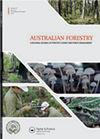Efficiency of nutrient use for biomass production of a Eucalyptus clone as a function of planting density in short-rotation cropping
IF 1.2
4区 农林科学
Q3 FORESTRY
引用次数: 11
Abstract
ABSTRACT The objective of this study was to assess the effects of planting density on nutrient use efficiency (NUE) in the production of biomass of a hybrid of Eucalyptus urophylla × Eucalyptus grandis. Twelve planting densities were evaluated at 36 months of age, ranging from 498 to 2564 plants ha−1. Three trees were harvested in each treatment to determine biomass production and allocation (per plant and per area), concentration (g kg−1), amount (kg ha−1), and NUE of N, P, K, Ca, Mg and S in the biomass of leaves, branches, bark and wood. In summary, the increase in planting density resulted in: higher biomass production per area; a reduction in biomass production per plant; a reduction in homogeneity; an increase in the concentration of N, P and K in leaves, of N, Ca, Mg and S in bark, and of N, P and K in wood; a higher amount of nutrients exported by harvesting; and a higher NUE for wood production. The increase in NUE indicates a possible nutritional deficit in trees at higher stocking rates at the age of three years. The higher the planting density, the sooner the site will require re-fertilisation.桉树无性系生物量生产养分利用效率与种植密度的关系
摘要本研究旨在评估种植密度对尾叶桉×巨桉杂交种生物量生产中养分利用效率的影响。在36个月龄时评估了12种种植密度,范围从498到2564株ha−1。在每个处理中收获三棵树,以确定叶、枝、树皮和木材生物量中N、P、K、Ca、Mg和S的生物量生产和分配(每株植物和每面积)、浓度(g kg−1)、数量(kg ha−1)以及NUE。总之,种植密度的增加导致:单位面积生物量产量增加;每株植物的生物量产量减少;同质性降低;叶片中N、P和K浓度增加,树皮中N、Ca、Mg和S浓度增加,木材中N、P和K浓度升高;通过收割输出的营养物质含量更高;木材生产的NUE较高。NUE的增加表明,在三岁时放养率较高的情况下,树木可能存在营养不足。种植密度越高,就越早需要重新施肥。
本文章由计算机程序翻译,如有差异,请以英文原文为准。
求助全文
约1分钟内获得全文
求助全文
来源期刊

Australian Forestry
FORESTRY-
CiteScore
3.70
自引率
4.80%
发文量
15
审稿时长
>12 weeks
期刊介绍:
Australian Forestry is published by Taylor & Francis for the Institute of Foresters of Australia (IFA) for scientific, technical, and professional communication relating to forestry in the Asia Pacific.
 求助内容:
求助内容: 应助结果提醒方式:
应助结果提醒方式:


